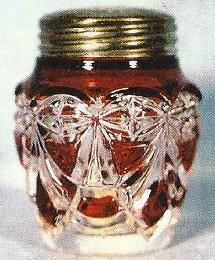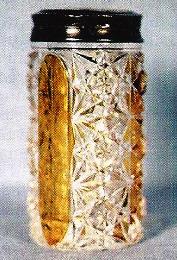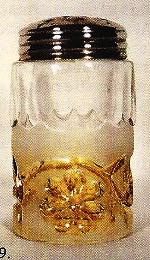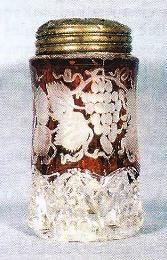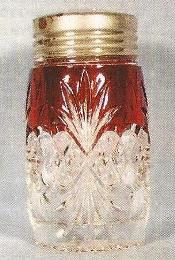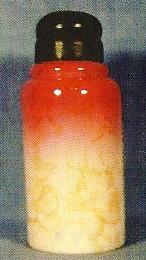Ruby Stained Glass Shakers: A Stain Can Be Beautiful!
by Marilyn Lockwood
(Reprinted from the June/July 1995 “Glass Collector’s Digest”, Volume IX, Number 1. Marilyn Lockwood was a member of AAGSSCS from its inception until her death in 1998. She wrote many articles for The Pioneer on shaker identification in her column, “Scribbles from a Salt Shaker Student.” She was the first president of our club and she and her husband, Chub, hosted the first AAGSSCS convention in Hornell, NY in 1986.)
A beautiful stain? No, not the “ooops, I spilled by coffee” kind, but the color on some Victorian glass.
Early in our collecting we looked at ruby-stained pieces as rather gaudy. Some of them are, when compared to the more delicate Smith Brothers and other decorations of that type. However, as our attachment to pattern glass grew, so did our appreciation of staining. When expertly applied, it complemented the patterns by emphasizing the intricacies and, of course, a well-stained piece usually brought a higher price than a clear item in the same pattern.
Figures 1: Bassettown (Duncan’s #40); 2: Riverside’s Victoria; 3: Fancy Arch (McKee); 4: Flat Diamond Box (Fostoria’s Lorraine); 5: Broken Column (U.S. Glass).
Those “flashed” pieces were so much more attractive than clear glass. Soon we were instructed that flashed was the wrong term. Research proved that advice valid. Flashed and stained are not the same, although the designation has become confused and commonly interchanged.
A little historical background is helpful in discussing parti-colored glass as it was called in those days. Bohemian Glass was known for centuries, but its display at New York’s Crystal Palace in 1853 caused a surge of popularity here. American glassmakers borrowed the idea, especially the bright red on crystal. However, it was expensive to produce because it required skill and speed in fusing the glass layers and the expertise of glass cutters.
Later this interest led to the development of flashing as a less costly method of producing a similar effect. The outer layer of glass, obtained with the use of gold in its formula, was very thin. Dr. Arthur Peterson, in Glass Patents and Patterns, describes four methods of producing flashed glass, all requiring degrees of skill in blowing and combining layers of glass. (This process is not to be confused with overlay or cased glass in which the contrasting colored layers were thicker and more uniform.)
Our study finally brought us to the 1880s and stained glass. The general public saw stained ware at the Columbian Exposition and its popularity soared throughout the 1890s and well into the 1900’s. Heacock declared that between 1891-1911 hundreds of complete lines of tableware were produced with ruby stain. In the 1920s its popularity had waned and stained items were sold as novelties and souvenirs.
Ruby was not the only stain used, although it was favored—perhaps because of its resemblance to Bohemian glass which it imitated. The color ruby was prepared in a chemical solution containing sulfate of copper or, as Kamm tells us, a gold salt in a transparent liquid (Figs. 1-5). The amber-stain compound contained nitrate of silver (Figs. 6-9). Heacock asserted that only a few dozen patterns were decorated in amber.
Figures 6: Millard (U.S.Glass); 7: Ellrose (Amberette)(G. Duncan & Sons); 8: Brilliant (Riverside); 9: Leaf & Flower (Hobbs)
Stains in pink (maiden’s blush), amethyst, and green were also used but less often (Fig. 10). The widespread use of gilding was a similar decoration made with oxide of gold or gold salt which had to be burnished after firing. It was used separately or with colored staining (Fig. 11).
Ruby stain was occasionally combined with enameling as a decoration. Fig. 12 shows Jefferson Glass Company’s “Diamond with Peg.” The enamel painting could be fired in the muffle (lkiln) at the same temperature required for the staining and created a very attractive piece. Fig. 13 shows a unique and rare shaker in a teal blue staining with red flowers on clear glass. This “states” pattern was named “Maine” by U.S.Glass.
10: Iowa.(toothpick), Portland Banded (shaker)(both U.S.Glass); 11: Panelled Dogwood (aka Navo)(Cooperative Flint Glass)(tumbler);
12: Diamond with Peg (Jefferson); 13: Maine (U.S. Glass)
Staining seemed to be the ultimate in economy in parti-colored glass. In a process called burning by the workers, the chemical fluid was applied by spraying, by dipping or painting with a brush to the moderately hot glass. It was then fired in the muffle to 1,000 degrees F. to fix the color on the glass. Sometimes decoration or souveniring was added by removing some of the stain before kiln firing or by etching (Fig. 14). A cheaper “color” process was also used and may account for some of the pieces whose staining shows the worst scratching and wear, since this manner of applying the stain did not cause it to adhere as well.
A breakthrough in the staining process came in December 1885 when a patent was granted to Daniel Ripley, Augustus Heisey and George Swift for a process to stain the raised surfaces of a pressed piece, leaving the depressed parts of the pattern clear before kiln firing. Their patent application mentioned that this process was in imitation of cut glass. This discovery allowed mass production in a quicker and less expensive way. It helped to usher in the relatively protracted era of stained glass popularity and availability.
The question of attribution is not a simple one. Some glass companies maintained their own decorating departments, thus adding their own staining. Some contracted the work with decoration firms which returned the glass to the manufacturers for sale. At times, glass blanks were bought outright, stained and marketed by the decorating company—either under the original manufacturer’s name or under its own designation. At other times the molds were sold passed around to companies within a conglomerate such as National Glass or U.S. Glass or sold to decorating companies who then went into manufacturing themselves. That whole confusing puzzle was discussed at some length by Heacock in his Book 7, Ruby Stained Glass from A to Z. He felt the glass should be credited to the manufacturer, not the decorator. I agree, when that can be determined.
The difficulty of absolute attribution is illustrated by the pattern “Red Block” (Fig 15). Heacock called the tumbler infamous because it was made by at least five companies, including Doyle and Co., George Duncan and Sons, Bryce Bros. and U.S.Glass. “Red Block” pieces are also shown in an ad of the Pioneer Glass Company which decorated much of it. The sugar bowl shows the scratching and wearing which occurred in stained pieces with much use. This was my grandmother’s, so the scratches are earned “family” ones.
Figures 14: Button Arches, reportedly decorated by Oriental; 15: Red Block
The Oriental Glass Company was a major decorator in the 1890s and at least a dozen years into the 1900s. They advertised “Originator of Ruby Work in America.” Pioneer Glass Company (later L.J.Rodgers), A.E.Mueller (later sold to National Glass), Cohn & Minnick and several others were advertised as decorators as well as glass companies who maintained their own departments.
Dr. Arthur Peterson pointed out that some patterns have been named as a clear glass pattern, then given an additional name for the stained version. For instance, the clear “King’s Crown” is well known as “Ruby Thumbprint” when stained. Another is Tarentum’s “Atlanta” also called “Royal Crystal” when stained (Fig. 16). These names are well established but, as he says, inappropriate. Peterson also gave us a hint on how to identify a stained piece. “Stained glass is more easily identified as such if some of the colored coating has worn off.” This decoration is vulnerable to scratching or marring when used extensively. The pink and green staining are subject to fading. The ruby stains may vary in shake or intensity. Parti-colored glass has enjoyed periodic revivals. In the 1930s Depression era, the Westmoreland Glass Company produced patterns with ruby staining (Fig. 17). “Fruit Band” (the Della Robbia pattern) and “Hundred Eye” are good examples. The former is especially collectible. One caveat: I have seen at least one piece, a toothpick holder, which was in old clear glass with “modern” staining. It bled red when rubbed gently with a tissue soaked in nail polish remover; a predictable result, no doubt, of the fact that staining increases the value of clear Victorian glass.
Our non-collector friends seem attracted to our ruby-stained shakers partially, I suspect, with a feeling of nostalgia and also because the color evokes and defines the great variety of patterns. They seem less interested in the othr colors of staining. Perhaps tastes have not changed that much, explaining why less staining was done in amber and other colors. That fact makes some of the latter more valuable and desirable to collectors today. Stains on pieces of art glass are much less common. The New England Glass Company made an Opaque Green which has a mottled band of blue-green staining. They used a similar process on some of their Peachblow pieces to create their Agata decoration, using Joseph Locke’s 1887 patent. The piece was coated with a metalic stain and splashed with a volatile liquid such as alcohol which evaporated to leave random splotches (Fig. 18). Both are very rare, perhaps indicating that the resulting decoration, with its added cost, did not appeal to potential customers. Also, the factory closed the following year, limiting production to no more than a year. Both stains were delicate and tend to be faded or washed off after over a century of existence.
Figures 16: Royal Crystal (Tarentum); 17: Fruit Band, Hundred Eye (Westmoreland); 18: Agata (New England Glass).
Stained pieces were available to accommodate any pocketbook and that holds true today for those who collect the “survivors.” Whatever your taste I trust you will agree—a stain can be beautiful!

